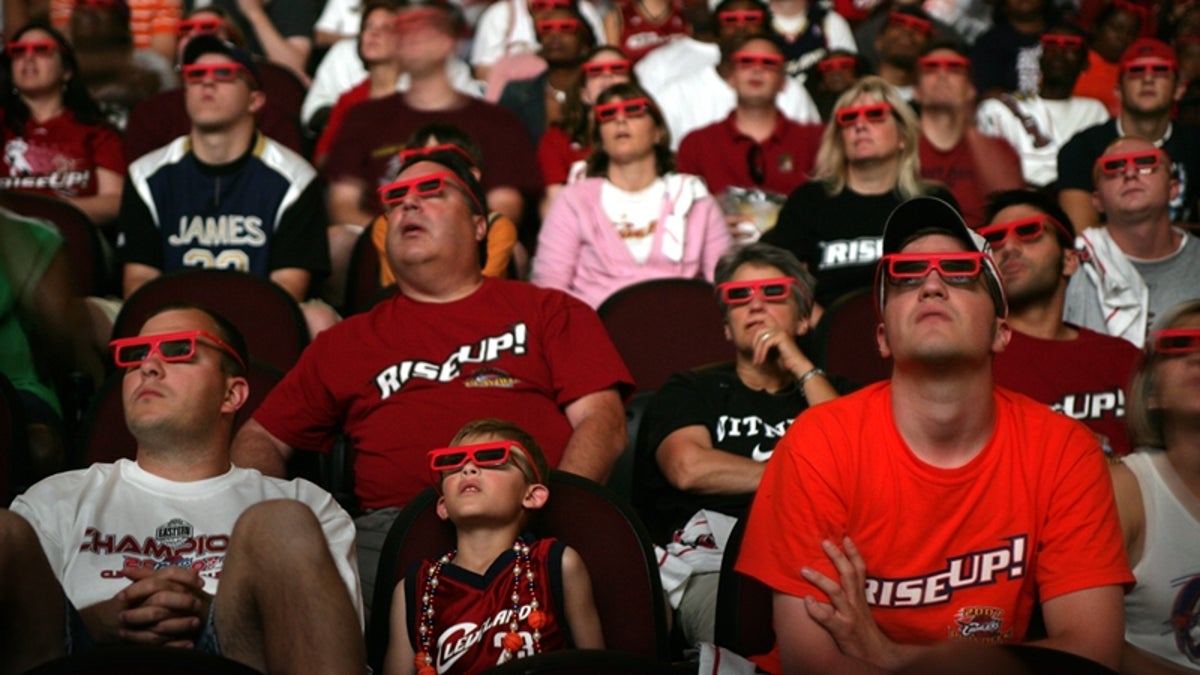NBA to air All-Star events in 3D theaters
The NBA is the first professional sports league to offer a live sporting event to fans in high-definition 3D in theaters around the country.

The NBA is teaming up with Turner Sports and Cinedigm Digital Cinema to broadcast live in 3D its All-Star Saturday Night events to 80 movie theaters across the U.S. on February 14.
The Live 3D event will be shown on up to 160 screens in 35 states across the country. Pricing for the tickets hasn't been set yet, but a representative from Cinedigm, the technology company behind the event, told the Los Angeles Times that tickets will likely sell for between $18 and $22 a pop.
This isn't the first event that the NBA has broadcast live in 3D. In 2007, it held special viewing parties in Las Vegas for the NBA All-Star 2007 events. And for Game 2 of the NBA finals in 2007, the Cleveland Cavaliers set up a 3D "theater" in the Quicken Loans Arena in Cleveland so that 14,000 fans could watch the Cavaliers play the San Antonio Spurs on four 60-foot screens. Also, in 2008, the Dallas Mavericks delivered a live 3D coverage of a game to a theater in Dallas to 500 fans.
"Taking the 3D experience nationwide is the next step," said Steve Hellmuth, executive vice president of technology and operations for the NBA. "It gives fans a chance to watch the NBA like never before."
Other sports leagues also see the potential in airing games in 3D. Last week, the NFL broadcast its Thursday night game between the San Diego Chargers and the Oakland Raiders in 3D to three theaters in Los Angeles, Boston, and New York as part of an invitation-only event to show off the technology. Fox Sports also said last week that it plans to air college football's Bowl Championship Series title game in 3D in theaters. And the network also hopes to air the Daytona 500 in 3D.
Right now these 3D viewing events all take place in theaters. But Hellmuth thinks that in the future 3D viewing might actually become more common in the home. TV makers are already starting to produce 3D capable sets. And more are expected next year as movies filmed in 3D come to DVD and Blu-Ray.
"What will really drive 3D into the home will be movies filmed in 3D," Hellmuth said. "And once there is more content, I think that makes the business case more compelling for delivering sports in 3D to the home."
The biggest hurdle right now for 3D content is the expense. It's not only expensive to shoot films or live events in 3D, but it's also expensive to deliver live broadcasts. Delivering live sports in 3D to homes on a regular basis would mean that paid TV providers like cable operators, satellite providers, and the phone companies, would have to upgrade their networks to accommodate these streams of content. Regular standard definition television broadcasts consume more bandwidth capacity than other types of traffic like audio or text. High-definition video eats up even more. And Hellmuth said it would likely take at least two full high-definition channels to broadcast live just one game in 3D.
But as service providers, like Verizon, deploy more fiber in their networks, capacity issues could be overcome. Still, it could take years for other providers, such as cable operators, to build the necessary capacity.
In the meantime, sports fans will likely be able to see some games and big sporting events in 3D in 3D-capable theaters. But Hellmuth said he doesn't expect regular season games to be shown in this way, simply because it would cost too much. But for big events, such as playoff or championship games, he believes there is a place for 3D broadcasts in theaters.
"There are certain events where people want to feel a sense of community," he said. "And I think that's when people will go to a theater to watch a game in 3D."
This makes sense. Most people watch regular season games in the comfort of their own home. But they often congregate somewhere for the really big games. Isn't that why there's always a crowd in the local sports bar during the World Series or why people have Super Bowl parties?

